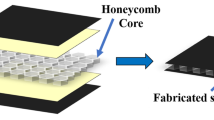Abstract
This study utilized experimental and finite element methods to investigate the mechanical behavior of aluminum honeycomb structures under compression. Aluminum honeycomb composite structures were subjected to pressing experiments according to the standard ASTM C365. Resistive forces in response to compression and maximum compressive force values were measured. Structural damage was observed. In the honeycomb structure, the cell width decreased as the compressive force increased. Results obtained with finite element models generated using ANSYS Workbench 15 were validated. Experimental results paralleled the finite element modeling results. The ANSYS results were approximately 85 % reliable.
Similar content being viewed by others
References
Q. Zhou and R. Mayer, Characterization of aluminum honeycomb material failure in large deformation compressive, shear, and tearing, Journal Engineering Materials Technology (2002).
S. T. Hong, J. Pan, T. Tyan and P. Prasad, Dynamic crush behaviors of aluminum honeycomb specimens under compressive dominant inclined loads, International Journal of Plasticity (2008) 89–117.
S. Xie and H. Zhou, Analysis and optimisation of parameters influencing the out-of-plane energy absorption of an aluminium honeycomb, Thin-Walled Structures, 89 (2015) 169–177.
H. Mozafari, S. Khatami and H. Molatefi, Out of plane crushing and local stiffness determination of proposed foam filled sandwich panel for Korean Tilting Train expressnumerical study, Materials and Design, 66 (2015) 400–411.
H. Yin, G. Wen, S. Hou and K. Chen, Crushing analysis and multiobjective crashworthiness optimization of honeycombs-filled single and bitubular polygonal tubes, Materials and Design, 32 (2011) 4449–4460.
K. K. Rao, J. K. Rao and K. S. A. Gupta, Heat insulation analysis of an aluminium honeycomb sandwich structure, Journal of Thermal Engineering, Yildiz Technical University Press, Istanbul, Turkey, 1 (3) (2014) 210–220.
Z. Wang, H. Tian, Z. Lu and W. Zhou, High-speed axial impact of aluminum honeycomb-experiments and simulations, Composites: Part B, 56 (2014) 1–8.
S. Fischer, Aluminium foldcores for sandwich structure application: Mechanical properties and FE-simulation, Thin-Walled Structures, 90 (2015) 31–41.
N. Pham-Thanh, H. Van Tho and Y. J. Yum, Evaluation of cavitation erosion of a propeller blade surface made of composite materials, Journal of Mechanical Science and Technology, 29 (4) (2015) 1629–1636.
M. Asadi, B. Walker and H. Shirvani, An investigation to compare the application of shell and solid element honeycomb model in ODB, 7th European LS-DYNA Conference (2009).
A. A. Nia and M. Z. Sadeghi, The effects of foam filling on compressive response of hexagonal cell aluminum honeycombs under axial loading-experimental study, Materials and Design, 31 (2010) 1216–1230.
G. Zhou and M. D. Hill, Impact damage and energy absorbing characteristics and residual in-plane compressive strength of honeycomb sandwich panels, Journal of Sandwich Structures and Materials, 11 (2009) 329–356.
S. T. Hong, J. Pan, T. Tyan and P. Prasad, Quasi-static crush behavior of aluminum honeycombs specimens under non-proportional compressive-dominant combined loads, International Journal of Plasticity, 22 (2006) 1062–1088.
T. Sadowski and J. Bec, Effective properties for sandwich plates with aluminium foil honeycomb core and polymer foam filling Static and dynamic response, Computational Materials Science, 5 (2011) 1269–1275.
M. Giglio, A. Manes and A. Gilioli, Investigations on sandwich core properties through an experimental-numerical approach, Composites Part B, 43 (2012) 361–374.
S. Xu, J. H. Beynon, D. Ruan and T. X. Yu, Strength enhancement of aluminium honeycombs caused by entrapped air under dynamic out-of-plane compression, International Journal of Impact Engineering, 47 (2012) 1–13.
X. Zhang, G. Cheng, Z. You and H. Zhang, Energy absorption of axially compressed thin-walled square tubes with patterns, Thin-Walled Structures, 45 (2007) 737–746.
V. Crupi, E. Kara, G. Epasto, E. Guglielmino and H. Aykul, Prediction model for the impact response of glass fibre reinforced aluminium foam sandwiches, International Journal of Impact Engineering, 77 (2015) 97–107.
W. Y. Jang and S. Kyriakides, On the buckling and crushing of expanded honeycomb, International Journal of Mechanical Sciences, 91 (2015) 81–90.
H. Akkus, M. Ekrem, S. E. Karabulut, H. Düzcükoglu, Ö. S. Sahin and A. Avci, Impact behavior of MWCNT reinforced epoxy adhesive bonded joints made with aluminium, 15th International Materials Symposium (IMSP’15), 15-17 October, Denizli, Turkey (2014) 742–748.
L. Liu, H. Wang and Z. Guan, Experimental and numerical study on the mechanical response of Nomex honeycomb core under transverse loading, Composite Structures, 121 (2015) 304–314.
Y. Hou, R. Neville, F. Scarpa, C. Remillat, B. Gu and M. Ruzzene, Graded conventional-auxetic kirigami sandwich structures: Flatwise compression and edgewise loading, Composites: Part B, 59 (2014) 33–42.
L. Aktay, A. F. Johnson and B. H. Kröplin, Numerical modelling of honeycomb core crush behavior, Engineering Fracture Mechanics, 75 (2008) 2616–2630.
Author information
Authors and Affiliations
Corresponding author
Additional information
Recommended by Associate Editor Choon Yeol Lee
Harun Akkuş was born in Bahçe/Osmaniye in 1987. He received his B.S. in 2008 and M.Sc. in 2010 from the Selçuk University. He has been completing his Ph.D. at the Selcuk University since 2011. He has been working as an Academician at Amasya University since 2011. He is working on machining, statistics, automotive technology, and finite elements issues.
Hayrettin Duzcukoglu was born in Çaycuma/Zonguldak in 1969. He graduated from Gazi University Mechanical Engineering Department in 1993. He completed his M.Sc. degree at Dumlupınar University Mechanical Engineering Department in 1996 and Ph.D. degree at Gazi University Mechanical Education Department in 2002. Dr. Düzcükoğlu is working on cogwheel, wear, coating, plain bearing, welding, and finite elements issues.
Ömer Sinan Şahin was born in Van in 1978. He received his B.S. degree in 1999, M.Sc. degree in 2001, and Ph.D. degree in 2004 from the Selçuk University. In 2007-2008, he visited the University of Delaware-USA as a Postdoctoral Researcher. Dr. Şahin has publications on fiber reinforced composites, hybrid nanocomposites, and infrared thermography.
Rights and permissions
About this article
Cite this article
Akkus, H., Duzcukoglu, H. & Sahin, O.S. Experimental research and use of finite elements method on mechanical behaviors of honeycomb structures assembled with epoxy-based adhesives reinforced with nanoparticles. J Mech Sci Technol 31, 165–170 (2017). https://doi.org/10.1007/s12206-016-1216-0
Received:
Revised:
Accepted:
Published:
Issue Date:
DOI: https://doi.org/10.1007/s12206-016-1216-0




